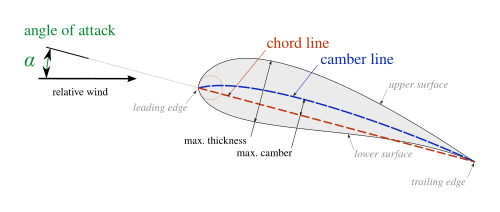Introduction:
The wing of the aircraft has a unique feature called the airfoil. An airfoil is a unique shaped surface that is used to lift and drag the aircraft while propelling. Airfoil can also be spelled as an aerosol. The lifting of an airfoil is solely due to the angle of attack. Check out our other articles under aviation – CCT Blog – Aviation
General aerodynamics of airfoil:
Did you know that a solid body that moves through a fluid body produces aerodynamic force? The aerodynamic force that acts on the airfoil can be resolved into two major components namely lift and drag.
The aerodynamic force that opposes the aircraft, moving through the air is called drag.


Lift:
Lift is considered to be a force that is produced by the dynamic effect of the air acting on the airfoil and acts perpendicular to the flight path through the center of lift (CL) and perpendicular to the lateral axis. Airfoil design is considered to be one of the major facets of aerodynamics.
Essential parts of aerofoil:
The essential parts of the aerofoil include the symmetric and nonsymmetric foils. The symmetric aerofoil is found to have identical upper and lower surfaces with the production of no life at zero angles of attack.
The applications of this type can be listed as the rotor blades of various helicopters.
Nonsymmetrical aerofoil is also known as a cambered aerofoil. They are found to have different chord lines and chamber lines. The advantage of this type is that it has a decent lift-to-drag ratio.
The stall characteristics, also prove to be good, thereby resulting in the production of a useful lift at zero angles of attack.


Features of airfoil:
Interestingly, the geometrical features of the airfoil can be defined by many terms that include the leading edge, the trailing edge, and the chord line. The front portion of the airfoil having a maximum curvature is called the leading edge. The rear end applies to the same definition as the leading edge at the rear end of the airfoil.
The chord line appears to be a straight line attaching leading and trailing edges. The highspeed powered aircraft requires low drag. While the lowlift airfoils are found to be thin and streamlined. The most fascinating thing to note is that slow aircraft used for carrying bulk loads use thicker airfoils with high drag and high lift.
Airfoils and supplementary fluid dynamic devices produce noise as an outcome of turbulence and unsteadiness found in the boundary layers and other viscous flow regions that grow from the surfaces. This is labeled selfnoise. Various studies and research are still in progress related to airfoils for the betterment of propelling. The usage of airfoils has a wide range covering the design of aircraft, propellers, rotor blades, wind turbines, and other applications of aeronautical engineering.
References:

Pingback: What is a lift in aerodynamic physics? How to generate lift in an aircraft? Explained clearly in general terms - Criss Cross Tamizh Blog